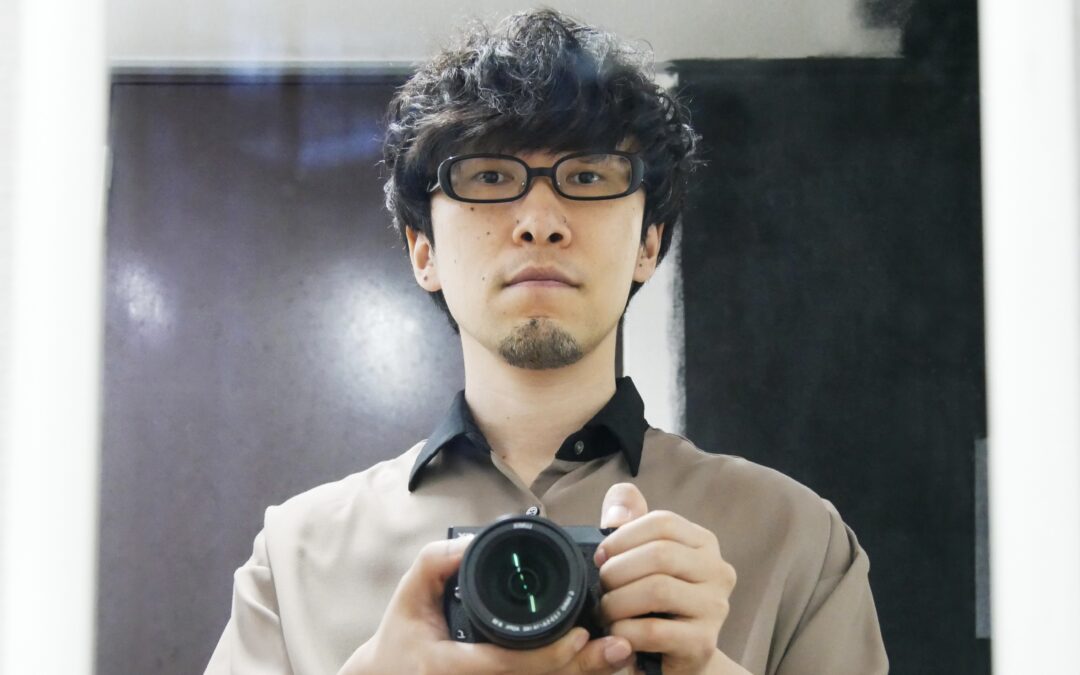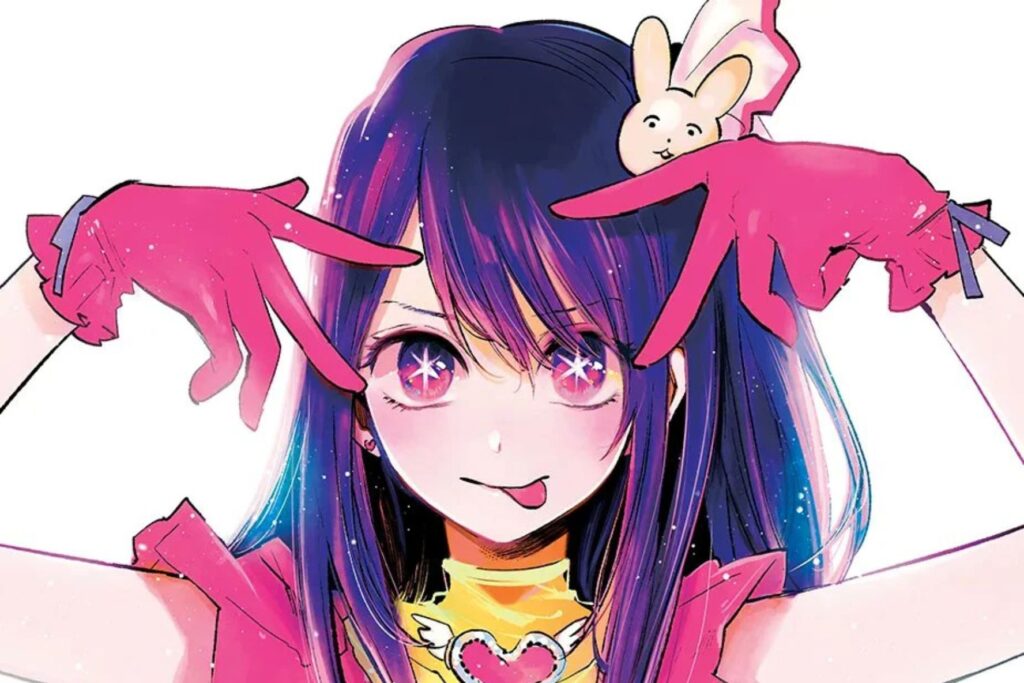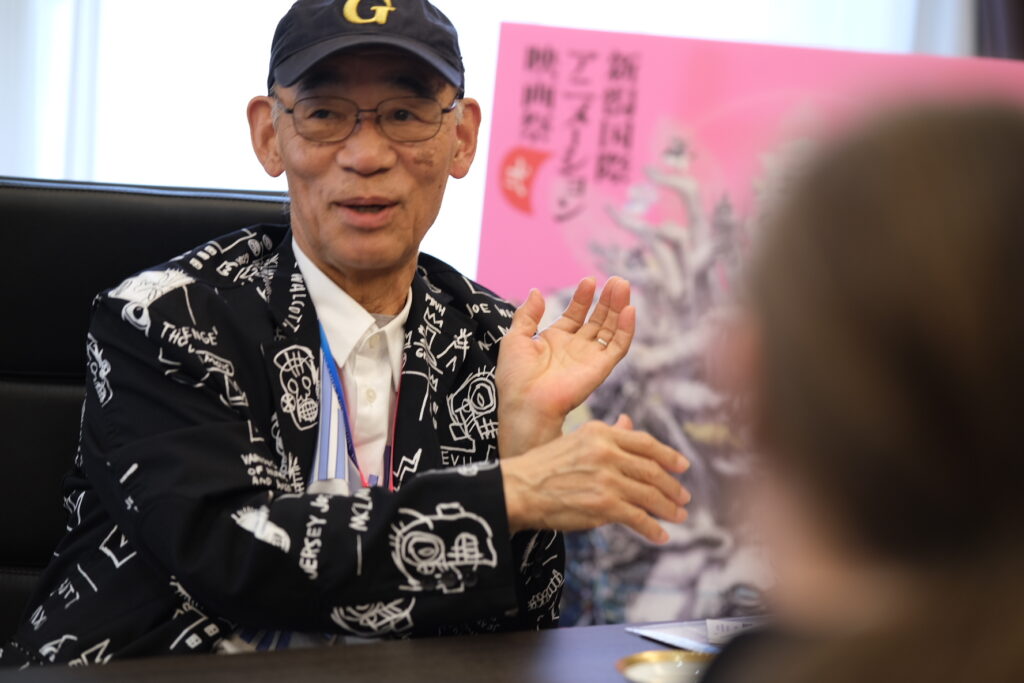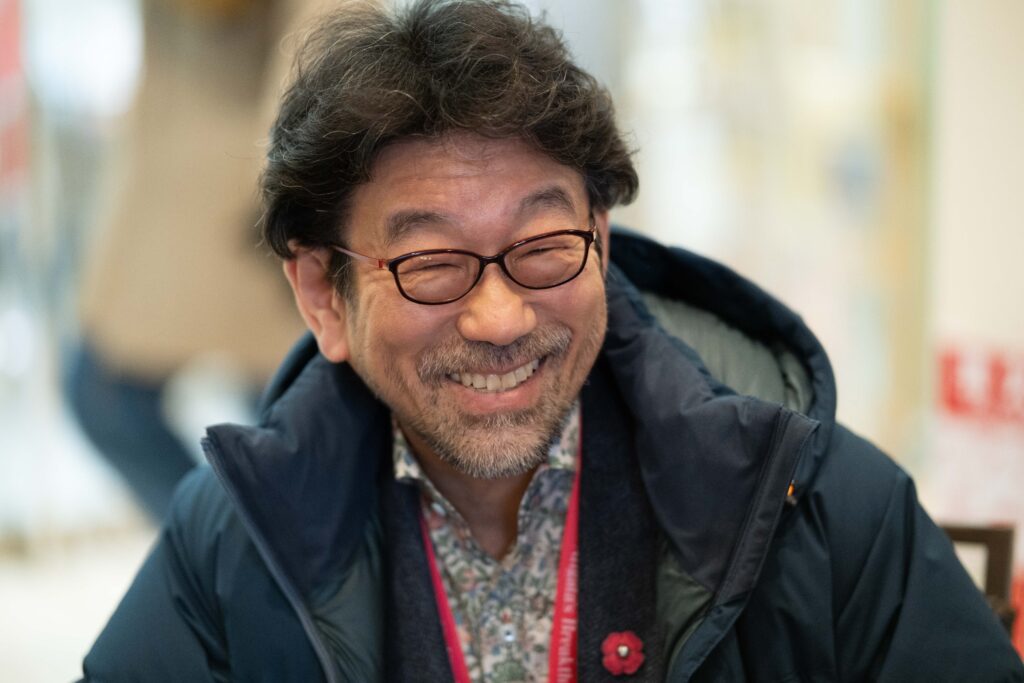At the start of the 2000s, several artists were able to claim some fame by releasing independent animated short films and leveraging that position to make their breakthrough into commercial animation.
One such name that comes to mind is Makoto Shinkai, whose movie Voices of Distant Stars, released in 2002, helped the movement to get enough attention.
One other such artist is Yasuhiro Yoshiura. In the 90s, the young Yasuhiro Yoshiura stumbles upon an advertisement for the video game MYST and is fascinated by the possibilities 3DCG can offer in terms of world-building. He starts learning 3DCG on his own with a Power Mac Apple Computer gifted by his grandparents and the CGI software Strata Studio Pro. By the year 2000, while he was still in college, he started submitting animated short films to NHK’s program Digital Stadium.
In 2002 his short film Mizu no Kotoba (The Words of Water) gathered a lot of attention in movie festivals and received several awards. He made his beginning in commercial animation through the short film Pale Cocoon and a few years later released the series The Time of Eve, which was released directly on Nico Nico Dôga and Yahoo Video. This was also when he starts calling himself Studio Rikka, a name used for him to work as a freelancer in the industry.
In recent years he has been noticed for his collaboration with Hideaki Anno’s Studio Khara. He directed two short films in the Anima(Tor) Expo Omnibus, were in charge of directing the Mobile Suit Patlabor REBOOT short film, and was a director on Kazuya Tsurumaki’s Dragon Dentist.
In 2021 his latest movie released in Japan, Sing a Bit of Harmony. This upbeat movie combining S.F. elements and musical comedy has received a small cult following in Japan. The movie was very well received by audiences, especially people working in the anime industry.
At the occasion of a premiere of Sing a Bit of Harmony at the animation festival Le Carrefour du Cinéma d’animation, we had the opportunity to sit down with Director Yoshiura and talk about how he approaches making their movies, his relationship with Studio Khara, his unconditional love of Patlabor, and the themes of his latest movie.
This article is available in Japanese. 日本語版はこちら
Like our content? Feel free to support us on Ko-Fi!
“If I still use 2D animation in my movies, it’s because of Kôji Morimoto”
You started as a self-taught independent artist, which meant you were taking care of everything by yourself. To this date, you are a director who has been taking care of a lot of the production by yourself. Was it a challenge to start working with other people, and do you find it hard to delegate tasks?
Yasuhiro Yoshiura: I wish I were able to delegate more work to other people. I tried to do it while working on my last movie, Sing a Bit of Harmony[1], at the start, but I ended up taking care of many things myself as the production went on. I want to find a work style where I can leave more things to other people.
While watching Pale Cocoon[2], if one doesn’t pay attention to the credit, one would think it’s a movie by Kôji Morimoto[3]. Can you tell us how Mr. Morimoto’s work influenced you at the time, and is he still an influence on you today?
Yasuhiro Yoshiura: First of all, let me say that Kôji Morimoto had an immense influence on me. When I started learning 3DCG and doing my first movies, I wasn’t interested in 2D animation but only in CGI. While I was studying CG, I discovered Kôji Morimoto’s short films, in which he beautifully integrates 2D characters in 3D environments. That left a huge impression on me, and I wanted to do the same thing. His works inspired me to do movies that combine 3D backgrounds and 2D characters. It’s what got me interested in 2D animation, and if I still use 2D animation in my movies, it’s because of him.
So, which one of his short films is your favorite?
Yasuhiro Yoshiura: It’s Extra[4]!
I’d say mine is Survival[5].
Yasuhiro Yoshiura: Ah, Survival! Well, obviously, I have watched all of his works, especially from that period.
One of the first times you work on something that isn’t your own original production is when you join the production of Evangelion New Theatrical Version: Ha[6]. You were credited for doing Design works. Can you tell us how you ended up joining the production and what exactly you were in charge of?
Yasuhiro Yoshiura: The Line Producer with whom I was working at the time was also working as a producer at Studio Khara. I received a request asking: “Mr. Yoshiura could you draw some for us?”
I was in charge of set designs and some backgrounds. In the movie, there is an aquarium, or rather it’s an aquatic laboratory. Director Anno[7] told me, “This is a scene that shows a lot about humanity’s destiny, so please imagine it.” But when I actually saw the movie, I was really surprised to see that it was a picnic scene!
At the time, Studio Khara focused a lot on developing its digital division, Studio Khara Digital Bu. How close were you with the department? Did you happen to help train the animators there, or were you just doing your things on your side?
Yasuhiro Yoshiura: No I didn’t do such things. While working on Mobile Police Patlabor REBOOT[8], I had a desk at Studio Khara, but I am not affiliated with the studio.
“The way Patlabor 2 was made is my biggest reference when making anime”
I think it’s a good opportunity to ask you about Patlabor REBOOT. You worked alongside Headgear’s Mr. Izubuchi[9] and Mr. Itô[10], two of Patlabor‘s original creators. I think I have heard that Mr. Itô incited you to take more responsibility on the project. Can you tell us more about it?
Yasuhiro Yoshiura: It’s not quite like that. There were talks about remaking Patlabor as a short film. I asked very directly, “I am a huge fan of Patlabor, so please let me direct it.” I really insisted on directing it. Obviously, Mr. Itô and Mr. Izubuchi have been really nice to me and cooperated a lot.
Patlabor 2[11] is a movie that revolutionized the Layout system. As you are a huge Patlabor fan, can you tell us how Mamoru Oshii’s[12] use of Layouts and camera works have influenced you? Especially since you also stand out through the frequent use of C.G. Layouts.
Yasuhiro Yoshiura: That’s right. There is a famous book that explains the Layout system of Patlabor, Patlabor 2: Methods[13]. Because I was influenced by Patlabor in the way I make movies, I often use it as a reference for my works. Every time I make a movie, I go through it.
Patlabor 2 had very talented artists in charge of Layouts. When making Patlabor REBOOT, I wanted to compete with the previous Patlabor works, so I did my best to catch up by using the techniques of 3D Layouts and CG Layouts I had accumulated until that point.
Also, in REBOOT, I was determined to make the Ingram fight in a very cool way.
“Most works about A.I. discuss its dangers, so I thought I would rather make something positive on the topic.”
I want to talk about your latest movie now, Sing a Bit of Harmony. Commonly when making anime, a drawn storyboard (絵コンテ) is used. But you work making a video storyboard (Vコンテ). Can you tell us why you work like that?
Yasuhiro Yoshiura: Because this movie is a musical comedy, the harmony between sound and visuals is extremely important. This is why I knew from the beginning that, in this case, it was necessary to do a video storyboard that would show how the sound and the images would work together. The video storyboard was a blueprint, that I thought I needed to do from the planning stage.
But it’s not limited to songs. I also put a lot of emphasis on the dialogues between characters and the rhythm of their exchanges. The video storyboards are very useful in determining these aspects from an early stage.
In this movie, there is a character, Shion, who is an A.I. She behaves very differently from humans, like a computer that follows its own logic and rules. It reminded me a lot of how Isaac Asimov[14] wrote robots and A.I.s. Is it just a coincidence, or is it the kind of Science Fiction you like?
Yasuhiro Yoshiura: I have been reading Asimov’s novels ever since I was a child. Since then, I have been immersed in his worlds, and I love how he writes about robots. I wouldn’t even say that Asimov has influenced me, but that I try to reproduce or adapt on screen what he imagined. Asimov wrote different types of novels, one of which is to show a robot that behaves in strange ways at the beginning of the novel. It is very different from humans and causes many problems and chaotic situations. But throughout the work, we discover that it had its own logic and reasons, which will help solve the problems in the end. I like these types of novels a lot. Sing a Bit of Harmony has this exact kind of story.
The characters in the movie live in a world where technology is everywhere and everything is connected. Shion, the A.I., takes a lot of advantage of it by exploiting and infiltrating systems. It’s not shown in a particularly positive or negative way. That is just how it is. But considering that the Internet of Things is becoming more prevalent, it’s a bit scary when one thinks about it, isn’t it?
Yasuhiro Yoshiura: It’s true that when Science Fiction fans went to see the movie in Japan, some of them thought this story was rather scary. I understand people who try to warn about the risks of technology, but there are too many of them! Most works about A.I. discuss its dangers, so I thought I would rather do something positive on the topic. Sometimes fiction can influence reality. That’s also one of the messages of the movie.
And even if the actions taken can seem like a scary use of technology, the characters are using it for a good cause, so the ends justify the means.
Yasuhiro Yoshiura: The characters are high schoolers, so they don’t question their relationship with technology or its dangers. They accept it and use it naturally. There are scenes where the adults do talk about the dangers of technology. The movie isn’t just a happy story, so it’s not like it’s trying to say that everything is fine with that technology. There is a dilemma; that’s what makes Science Fiction interesting.
Before making Sing a Bit of Harmony, you were working on a different project that was canceled.
Yasuhiro Yoshiura: You’re well informed. [laughs]
Can you tell us anything about it? Did you reuse some elements of it for Sing a Bit of Harmony?
Yasuhiro Yoshiura: Yes, I did. The canceled project was a movie with a boy and a girl as protagonists, a young-adult fiction kind of work. I reused some elements of that story in Sing a Bit of Harmony; the setting of high schoolers doing their best is inherited from it.
Today when we look at the anime industry, many directors from the old guard who were doing S.F. are quitting. Mr. Tomino[15] might retire soon, Mr. Anno is focusing on Live Action. On the other hand, the young generation of directors doesn’t seem to want to make Science Fiction; for example, Mr. Shinkai [16], who, despite starting by making Science Fiction works, has never revisited the genre. When one thinks about it, except you, there aren’t many directors making feature-length Science Fiction anime, especially not on original ideas. What do you think is your place in the industry today compared to ten years ago when you released Patema Inverted [17], and what is the place of the Science Fiction genre?
Yasuhiro Yoshiura: By doing Sing a Bit of Harmony, I realized that the theme of A.I. had become a well-known topic. When I made Time of Eve, AI was not a topic the average person would understand; it was limited to people interested in Science Fiction. It wasn’t a very accessible topic. Today, A.I. is used everywhere, and everyone knows what it is.
Science Fiction used to be a niche limited to people interested in it, but now elements of Science Fiction have spread widely, and it has become a genre that can reach everyone.
I love Science Fiction, but I’m not a huge fan of hard S.F. I write stories where an A.I. robot joins a high school class or about a world where gravity is inverted. It is very accessible, classic Science Fiction. I think people have become more receptive to classical Science Fiction elements.
However, I feel that there are still some preconceptions that will turn people away if you insist too much that your movie is Science Fiction. That’s why regarding Sing a Bit of Harmony we never said it’s a Science Fiction movie in the advertising, although that’s still what I did.
I think we have time left for just one more question. It will be a short one. Are you, by any chance working on Mr. Izubuchi’s next Patlabor anime, Patlabor EZY? And if you do, can you tell us anything about it?
Yasuhiro Yoshiura: Mr. Izubuchi has asked me multiple times to participate, but the timing didn’t match, so I don’t have any plans to participate in it for now. But I hope that the Patlabor franchise keeps producing new works, and if an opportunity opens up for me to work on it, I definitely want to take it!
Interview by Dimitri Seraki.
Interpreter Ms. Shoko Takahashi
We wish to thank Director Yasuhiro Yoshiura for their time, as well as Mr. Kai Nakamichi from Bandai Namco Filmworks, Mr. Timothy Killian from All the Anime France, and Ms. Diana-Odile Lestage from Le Forum des Images for making this interview possible.
Notes
[1] Sing a bit of Harmony. 2021, movie, dir. Yasuhiro Yoshiura, J.C. Staff.
An upbeat musical comedy movie in which a group of high schoolers befriends a weird A.I. that joins their class, and they have to maintain the A.I.’s identity secret.
[2] Pale Cocoon. 2006, OVA, dir. Yasuhiro Yoshiura, DIRECTIONS.
Director Yoshiura’s commercial debut. It is a 23-minute-long Science Fiction short film. After a catastrophe that forced humanity to move into an underground base, an archive team tries to recover parts of Human history that have been lost.
[3] Kôji Morimoto (1959-) Director, animator.
After having collaborated with directors Osamu Dezaki and Rintarô at studios An Apple and Madhouse, Morimoto became the assistant animation director of Akira under his master Takashi Nakamura. Following the creation of Studio 4°C, he started doing increasingly experimental works, which earned him a cult following.
[4] Extra. 1995, Music Video, dir. Kouji Morimoto, Studio 4°C.
Morimoto’s first music video. Made for Japanese techno artist Ken Ishii.
[5] Survival 2.7-D Animated Version. 1999, Music Video, dir. Kouji Morimoto, studio 4°C.
Morimoto’s music video for the visual-kei rock band GLAY. It remains to this day the highest-selling MV in Japan.
[6] Evangelion New Theatrical Version: Ha. 2009, dir. Hideaki Anno, studio Khara.
The second entry in the Evangelion New Theatrical Versions tetralogy, in which the plot starts to diverge from the original T.V. series prominently.
[7] Hideaki Anno (1960). Director, animator.
Co-creator of studio Gainax, Hideaki Anno is most famous for being the director of the extremely influential Evangelion series. Having now created his own studio, Studio Khara, he seems to have turned to live-action movies along with his friend Shinji Higuchi, such as Shin Godzilla, Shin Ultraman, and Shin Kamen Rider.
[8] Mobile Police Patlabor REBOOT. 2016, dir. Yasuhiro Yoshiura, studio Khara.
A short film in which Yasuhiro Yoshiura revisits the Patlabor franchise. The film was supposed to be full CGI, just like Shinji Aramaki’s EVA Another Impact short movie from Anima(Tor) Expo, but Director Yoshiura insisted on the use of 2D characters.
[9] Yutaka Izubuchi (1958-). Character designer, director.
One of the most important mecha designers of the 1980s and 1990s, he was one of the members of the collective Headgear, the creators of the Patlabor franchise. He is still active on the franchise and expected to direct its next entry, Patlabor EZY.
[10] Kazunori Itô (1954-). Writer.
Prolific anime writer and member of Headgear, most known for his collaborations with Mamoru Oshii (Urusei Yatsura, Patlabor, Ghost in the Shell) and his work on the .hack franchise.
[11] Patlabor 2. 1993, dir. Mamoru Oshii, Production I.G.
Mamoru Oshii’s second and last film in the Patlabor franchise. It is generally considered to be one of the greatest anime movies of all time. It is especially praised among animators for its realistic animation and the quality of its setting. Both of these were supported by an unprecedented reliance on the “layout system,” in which extremely detailed blueprints of each shot and its camerawork were made by specialized artists before the animation.
[12] Mamoru Oshii (1951-). Director.
One of the most important anime directors of all time, known for his meditative, philosophical works. On movies such as Patlabor and Patlabor 2 or Ghost in the Shell, he pioneered an extremely realistic approach to animation and direction.
[13] Patlabor 2: Methods. 1994 book, Mamoru Oshii, Kadokawa.
A book edited by Mamoru Oshii containing detailed information about the production of Patlabor 2, notably about its “layout system” and the decisions that presided to the overall cinematography. Cited by many anime creators, it remains an extremely influential book to this day.
[14] Isaac Asimov (1920-1992). Writer.
One of the most important science-fiction novelists of all time, he is mostly known for his works regarding robots and artificial intelligence. He notably formulated the famous “Three Laws of Robotics,” supposed to regulate the behavior of robots.
[15] Yoshiyuki Tomino (1941-). Director.
One of the most famous and influential anime directors of all time, most famous for being the creator of the Mobile Suit Gundam series.
[16] Makoto Shinkai (1973-). Director.
Former video game creator who started making independent movies in the early 2000s, Shinkai played a major role in the development of the Sekai-Kei genre with his 2002 short Voices From A Distant Star. Since then, he has become famous for worldwide hits such as Your Name and Weathering With You.
[17] Patema Inverted. 2013, dir. Yasuhiro Yoshiura, Studio Rikka.
Yasuhiro Yoshiura’s first feature-length movie. It is an adventure movie mixing in some SciFi elements in which a boy meets a girl for whom gravity is inverted.
Like our content? Feel free to support us on Ko-Fi!
You might also be interested in
Oshi no Ko & (Mis)Communication – Short Interview with Aka Akasaka and Mengo Yokoyari
The Oshi no Ko manga, which recently ended its publication, was created through the association of two successful authors, Aka Akasaka, mangaka of the hit love comedy Kaguya-sama: Love Is War, and Mengo Yokoyari, creator of Scum's Wish. During their visit at the...
Ideon is the Ego’s death – Yoshiyuki Tomino Interview [Niigata International Animation Film Festival 2024]
Yoshiyuki Tomino is, without any doubt, one of the most famous and important directors in anime history. Not just one of the creators of Gundam, he is an incredibly prolific creator whose work impacted both robot anime and science-fiction in general. It was during...
“Film festivals are about meetings and discoveries” – Interview with Tarô Maki, Niigata International Animation Film Festival General Producer
As the representative director of planning company Genco, Tarô Maki has been a major figure in the Japanese animation industry for decades. This is due in no part to his role as a producer on some of anime’s greatest successes, notably in the theaters, with films...





Recent Comments